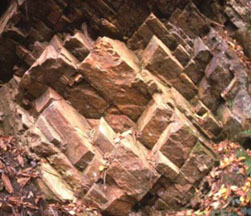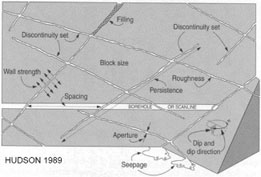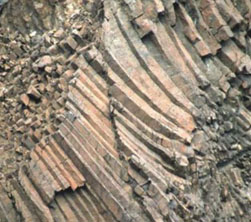| Article Published on October 15th' 2008 Back to Main Page | |||||||
| Physical properties of rock masses | |||||||
| Most
of the engineering structures like dams, tunnels, underground power
house, roads etc. involves large volume of rock mass. The rock mass
is generally more heterogeneous than intact rock. The rock mass contains
discontinuity planes in the form of joints and fault planes, bedding
plane and foliations. These discontinuity planes are responsible
to give different physical properties to rock mass compared with intact
rock sample from the same rock mass. These discontinuity planes are responsible
to control the strength and the deformability of the rock mass. |
Spacing:
The spacing of discontinuity affect the overall strength of the rock mass. If the spacing is less the strength will be less and if it is more strength will be more. Continuity: The continuity of discontinuity planes influence the stability of the rock mass provided the orientation of discontinuity is kinematically critical. If the continuity of the discontinuity planes is more the strength of the rock mass will be less in comparison to case when continuity is less and there are bridges in between. Surface Characteristics: Three factors are involved when the surface characteristics of discontinuities are considered. a) The waviness or undulation of the surface, which results in variations in orientation or attitude along a given discontinuity. For joint roughness assessment though there are many methods but very widely used method is to compare the roughness profiles provided by Barton and Choubey (1977). b) The smaller scale roughness of the surface, which provides friction between two adjacent blocks. c) The physical properties of the infilled material between the two surfaces of discontinuity plane. Waviness and roughness are first and second order irregularities based on their relative magnitudes. The projections in a rough discontinuity surface are called asperites. Waviness has a greatest influence on the rock mass strength than roughness. For two adjacent block to move along a wavy surface, there must be displacement normal to the surface. The amount of displacement is controlled by roughness angle and the wavelength of the wave. The waviness angle reduces the dip angle and thus tendency for sliding is also reduced. Separation and Filling of Joints: The separation of joint surface
and the presence of filling material in between has a great influence
on the strength of jointed rock mass. The separation width affects the
shear strength of the joint. If the joint is tight the asperites in the
joint surface will interlock and will improve the shear strength.
Whereas if the separation is wide the influence of the infilling material will reduce the shear strength. References Goodman, R.E., 1989, “Introduction to Rock Mechanics”, John Wiley and Sons, New York. Hoek, E and Bray, J.W., 1997, “Rock Slope Engineering”, E&FN Spon and Imprint of Chapman and Hall, 2-6 Boundary Row, London SEI 811 N, UK. Johnson, R.B and Degraff, J.V, 1991 “Principles of Engineering Geology”, John Wiley and Sons, New York. |
||||||
Discontinuities
Characteristics
The important factors of discontinuity planes which influence the properties of the rock mass are; i) Orientation, ii) Spacing, iii) Continuity, iv) Surface Characteristics, v) Separation of disco-ntinuity Surface and vi) Thickness and nature of filling material. Orientation: Orientation of the disco-ntinuity planes play an important role in the strength of the rock mass. The rock mass fail along one or more discontinuity planes. The role of orientation of discontinuities becomes most important for rock slope stability if: (a) discontinuity plane or plunge of line of intersection of two wedge forming planes day light the slope at less than the slope angle. (b) whether the dip of the joint plane or plunge of the line of intersection exceed the angle of internal friction. If these conditions are prevailing the slope is kinematically unstable. The orientation of discontinuities also influence the strength of rock mass.
|
|||||||
| |
|
||||||


